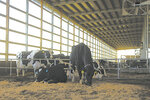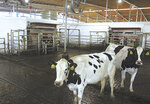


GREENWOOD, Wis. – Over seven years of careful consideration and planning, along with touring over 40 dairy farms throughout the Upper Midwest, laid the groundwork for a robotic milking system at Boon Farms in Greenwood.
[[In-content Ad]]
Shortly after purchasing the farm from his father Duane, Brad Boon came to a crossroads in decision making. The farm’s current parlor needed substantial upgrades. After his years of research and planning, Boon felt he was ready to take the plunge and build a new freestall barn for a robotic milking system.
“We were milking in a slow, outdated parlor,” Boon said. “It took five to six hours to get them all through. We were milking three times a day, so it was almost 24 hours a day.”
Just over a year after the start up, Boon prefers not to remember life before the robots.
“I wouldn’t want to do it any other way,” Boon said. “We are just loving it.”
The Boons milk 355 cows with six Lely A5 robots, which were started up on Oct. 26, 2020. There are 100 head milked twice a day in the farm’s old parlor. The two herds operate independently, including dry cow facilities.
“I am blessed with great employees, long-time employees who know cows really well,” Boon said. “Some have been with us for nearly 20 years. We kept a group of cows milking in the parlor so that I wouldn’t need to let anyone go after things got settled in with the robots. That has been part of our success; our employees have been really good to us.”
Boon plans to eventually incorporate the two herds together as his work force shrinks through natural attrition.
“This barn is built with an off-set peak and is designed for easy expansion to add more cows,” Boon said. “So we will be able to add on and add a couple of more robots to bring the parlor cows up here.”
As the dust has settled after the first year, the robotic conversion has been everything Boon had hoped for and maybe even a bit more.
The tunnel-ventilated barn is built with two identical milking pens, each with three robots. One side houses primarily first lactation cows, while the other side houses mature cows, all in sand-bedded free stalls. The barn also includes a dry cow and maternity area, where the stalls have mattresses, along with room to keep newborn calves before they are moved to calf hutches outside.
Each pen features drive-thru feeding, and manure is cleaned using an automatic manure scraper. An auger and piston pump move the manure to the pit. Future plans include the installation of a manure separator. Boon said he would like to have solid and liquid waste so the farm can reclaim and recycle the water.
“I think that is the way the industry is heading,” Boon said. “Sustainability and sound environmental practices are going to drive everything we do on the dairy farm.”
Along with sustainability, Boon said the installation of the robotic milking system has allowed him more time for the things he enjoys about dairy farming: caring for the cows and focusing on their needs.
“It has made for a huge reduction of labor needed,” Boon said. “Our cows are healthier. We are now getting more milk per cow, but it took a while to get there. For most of the first year, we stayed about where we were in the parlor. But, as cows are calving back in and starting new lactations, we are now seeing an increase.”
The robots are placed in an L-shaped design, with two robots for each pen in the main robot room and a free-standing robot room for each pen, situated perpendicular to the main robot room. The free-standing robots allows for fresh cows to be kept in the separation pens until Boon changes their status in the computer.
Boon said the primary focus, after cow comfort, when planning the new barn was with an eye on labor efficiency.
“I didn’t realize how valuable those separation pens were until maybe six months in,” Boon said. “We don’t have to fetch fresh heifers because we keep them in there as long as we need to, to make sure they are going to the robot regularly. We use the separation areas for locating and catching cows for everything from breeding to hooftrimming to herd health work.”
In the parlor, Boon said the herd typically averaged about 90 pounds of milk per cow per day. As the new lactations are beginning, the robotic herd is now averaging nearly 100 pounds per day with a 4.1% butterfat test. The cows are averaging right about three visits to the robots each day.
Boon said the herd transitioned to the robots better than he expected.
“We weren’t able to bring them up here to go through the robots before the startup,” Boon said. “When we moved them up here, that was it; they were getting milked in the robots. We pretty much pushed them through for the first week, and then they caught on.”
Within a matter of time, the majority of the cows were visiting the robots frequently on their own, leaving the fetch list pleasingly small.
“By week three, our milk production was back to where we were in the old barn, and we were fetching maybe 10%,” Boon said. “By week four or five, it was down to maybe five cows on each side. … So, 10 cows out of 360; that is pretty darn good.”
Boon has been thrilled with the benefits and improvements he has witnessed throughout the entire farm since starting up the robots.
“The conversion to robots is for my employees as much as it is for us,” Boon said. “They are the key to the whole operation, and I want them to be happy. It has improved the quality of life so much for all of us.”
Comments
No comments on this item Please log in to comment by clicking here